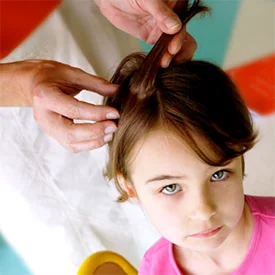How Do You Get Lice? Common and Not-So-Common Ways
We fear what we can’t see.
No one observes themselves getting lice. The awareness comes later after the symptoms show up and then you have to look really really carefully to confirm.
It is common to associate unsanitary conditions with lice. Maybe it’s because lice are bugs and we think of bugs as being dirty. The fact is, however, that being dirty has nothing to do with having lice and being perfectly clean does nothing to protect you from lice.
When it comes down to it, there are not too many ways that lice are spread. Knowing the possibilities of how to get lice, rather than making you paranoid, can help you to worry a little less. And if you do happen to get lice, there is a simple and straight forward way to take care of them in short order.
The Common Way to Get Lice
Lice are spread by head to head contact.
The only environment for head lice to survive any length of time is the human scalp. Because of this specificity, they stay with their host unless presented with a new scalp nearby.
Although it may seem like lice have super powers to just show up, in fact, they cannot fly or even hop. That’s right, they can only crawl.
The common means of getting lice, then, is almost the only way that lice spread. Someone without lice has direct contact with the head of someone infested with lice. Head lice do not live on body hair, just head hair.
You won’t get lice simply being in the same room as someone with lice. You won’t get lice shaking hands with an infested person. And remember, having lice has nothing to do with hygiene.
It is most common for children to get lice and it is because of the common head to head contact. It is a beautiful thing to watch the carefree play of children as they run around the playground. Sometimes three kids will go down the slide at the same time.

These kids could all be getting lice right now.
Or, perhaps, two or more children will sit close together to watch a show or play a video game. It is wonderful to see these moments, but lice are opportunistic and will seize the chance to move to new territory.
Thankfully, there is a simple and quick method to kill lice that I will return to at the end of this article.
The Not-So-Common
Most cases of lice are spread from head to head contact. Lice cannot survive for long apart from the human scalp so it is uncommon to get lice by another means, but it does sometimes happen.
Hats and brushes are perhaps what many people would think of for spreading lice. It is possible to get lice from an infested person’s brush or hat. However, adult lice do not live for long without a meal of blood and nits are unlikely to hatch apart from the body heat of their host. Additionally, if they do hatch on a hat or brush, they would need a meal of blood immediately or they will not survive.
That is to say, lice cannot hibernate for months on a brush or a piece of clothing just waiting for you to try it on. The infested person would have needed to have contact with the brush or clothing very recently for lice to spread that way.
The CDC puts it this way, “Spread by contact with clothing (such as hats, scarves, coats) or other personal items (such as combs, brushes, or towels) used by an infested person is uncommon. Personal hygiene or cleanliness in the home or school has nothing to do with getting head lice.”
Another article even mentions that live lice were found on only 4% of the pillow cases of infested individuals! That is to say, a louse wants to stay close to their source of heat and food. So infestation through contact with clothing, bedding, or stuffed animals is not very common.
The Most Exciting Way
This last uncommon form of lice spreading warranted it’s own section because it is so exciting…or maybe just bizarre. Apparently, static electricity can build up to the point that lice are shot out of an infested person’s hair! Here is the quote, “there are reports that combing dry hair can build up enough static electricity to physically eject an adult louse from an infested scalp for a distance of 1 m.” Of course, that ejected louse would still need to land in someone else’s hair for it to survive, but I guess it is a possibility!
What to Do
In the end, you can rest assured. Let your children play with their friends and enjoy the beautiful aspects of childhood.

Head lice treatments in process
The Lice Clinics of America have a growing number of clinics to handle head lice. In about 90 minutes the head lice and eggs will be taken care of without any chemicals or harsh treatments.











Leave a Reply
Want to join the discussion?Feel free to contribute!